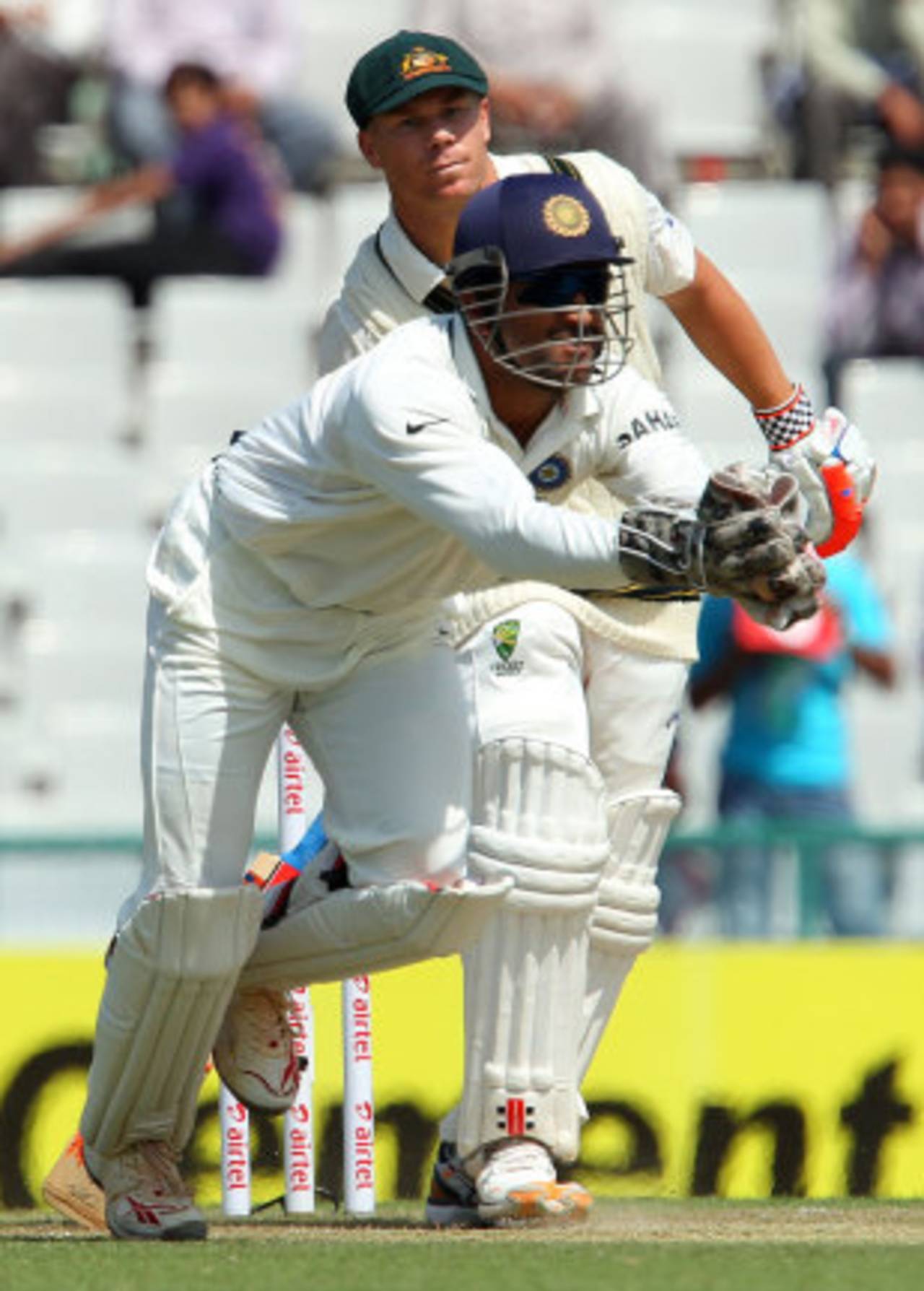Apart from those contests, India had never won three Tests in a home series of any length. Not even during their
17 wins in 30 home Tests during the rampaging 1990s. India's only other clutch of three Test victories came, along with a chuckle from the gods, overseas. In 1968-69, India achieved their first away series win with
a 3-1 result New Zealand.
In Mohali, India's unassailable 3-0 lead against Australia was a fist pump at history. Such a score line had been achieved after a two-decade gap and beating Australia by six wickets had returned the Border-Gavaskar Trophy to India.
India's pursuit of the target of 133 had a bit of a late flutter following Virat Kohli's departure with 30 left to get. It took two boundaries from Ravindra Jadeja in the 33rd over to ease India and Dhoni's growing anxiety. Butterflies had begun fluttering during a passage of about six overs after Kohli was out, when all four results became an imagined - even if remote - possibility.
This Border-Gavaskar Trophy has turned out to be as unequal a contest as it was in Australia in 2011-12. India had battled in the first Test in Melbourne, and Australia's mongrel barked and bit as they tried to defend 133 in Mohali. A 3-0 result, however, is the differentiator in quality between the teams in conditions that have asked mind-altering questions of these new-age Australians. And India have discovered with much satisfaction that this Australia are nowhere close to their old-age compatriots.
The India in Mohali are new-age themselves, but have so far swept away all doubts of their superiority at home over teams of a particular standard. Australia are ranked No. 3 in the ICC Test rankings, one spot ahead of India. Considering how they have played in this series, a round of polite coughing wouldn't be uncalled for. Even between their two embarrassing 0-4 defeats in England and Australia, India beat New Zealand, West Indies and now Australia.
Following this performance, there's a good chance the 1-2 defeat against England will be swept away in the wash of euphoria because India's formula at home has been nailed. The Duncan Fletcher move of including Ravindra Jadeja in the XI and having Dhoni bat at No. 6 has given the captain an additional option with the ball, even if a wee bit more sweat with the bat.
This has enabled India to come back in every game that they bowled first, even after conceding 400-plus in the first innings. The efficiency of India's turnaround against Australia has been impressive. That it came from the newbies - Shikhar Dhawan, Bhuvneshwar Kumar, Ravindra Jadeja, and the born-again M Vijay - gives the selectors the opportunity to walk around whistling.
In the chase on the fifth day, India were trotting at more than 3.50 runs an over before Kohli was dismissed. That was when Peter Siddle and Mitchell Starc began to put the squeeze on new man Dhoni. Eventually Jadeja's free-style hitting set his side free, the match eventually won with 15 balls to spare.
That margin is a bit supermodel-sized: looks good at a distance, but up close it can appear a little scrawny. It was a result of both the pressure exerted by the Australians after the Kohli dismissal, as well as India's generosity with time and runs, allowing the last three Australian wickets to put up 97.
Somewhere along their press against the Australian batsmen, one of India's successful bowling formulas, particularly at home, turned into a commandment. Thou shalt give only the new ball to Bhuvneshwar Kumar.
It was Bhuvneshwar who had broken through the top of the Australian batting but following his eight-over burst on Sunday evening, the next time he bowled was after 66 overs, when Australia had scored 129 more runs. The ninth and tenth wicket had put on 55 and Bhuvneshwar appeared, because of course the second new ball had to be taken.
India's spinners had done well to reduce Australia to 143 for 8, a lead of 52, yet somehow even with five bowlers, kept their options down to only four for a better chunk of the day. Yes, it is hard to spread the overs around five bowlers but to not give the fifth a go?
Dhoni's careful explanation for not bringing Bhuvneshwar on had to do with his lack of pace and the need to keep him fresh. "Well Bhuvneshwar is not someone who is too quick but can move the ball, so it's important that we use him with he new ball more, when the ball is skidding on a bit there's slightly less time for batsman to adjust," Dhoni said. "And if that's not the case I try to keep him fresh. Mostly we bowl 125 overs and which means second new ball is also due.
"As I said, first day there was not much pace for the fast bowlers and there was not much movement also. Generally Bhuvneshwar is someone who swings it, doesn't matter what the condition is he gets the swing, but that was not the case." Dhoni emphasised that Bhuvneshwar be used, "more with the new ball, especially in the subcontinental conditions."
It is a handsome theory but on the field, as India struggled to get a lower-order wicket with their spinners, it was as if a limited-overs formula - X for the new ball, Y for the middle overs to contain and Z for the slog overs, and if it doesn't break, no need to fix it - had been put into place in Test cricket. Yet, against a wavering opposition in the comfort of home, India will always have plenty of leeway.
And if the result ends up 3-0 anyway, everything else becomes nit picking.
Sharda Ugra is senior editor at ESPNcricinfo
